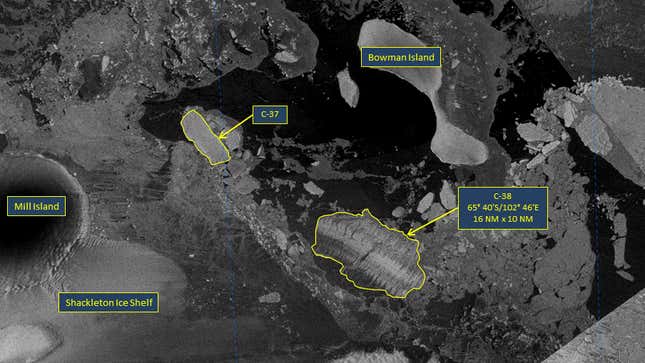
An ice shelf the size of Hong Kong has collapsed in eastern Antarctica, spawning a large iceberg and concerns that unusually warm temperatures in the region might be responsible.
In a March 24 tweet, Catherine Colello Walker, an Earth and planetary scientist from NASA and Woods Hole Oceanographic Institute, posted combined images gathered by the Landsat and MODIS satellites showing the “complete collapse” of eastern Antarctica’s Conger ice shelf. The 463-square mile (1,200-square-kilometer) ice shelf is now gone, replaced by open ocean and countless bits of floating ice. Oh, and a 18.4-mile-long (29.6-kilometer) iceberg designated C-38.
The timing of the satellite images suggests that the Conger ice shelf, which sat just to the east of the gigantic Shackleton ice shelf, collapsed around March 15 and that visible disruptions to Conger started to appear earlier in the month. Ice shelves extend from ice sheets and rest atop the ocean. Warmer waters “weaken the floating ice shelves that form in key places along the coast,” according to the U.S. Environmental Protection Agency, adding that “ice shelves help to hold back the flow of ice on land, so as ice shelves shrink or disappear, ice from the ice sheet can flow into the ocean more quickly.”
Helen Amanda Fricker, a professor of glaciology at Scripps Polar Center, said east Antarctica has experienced three distinct iceberg calving events this month, including the “dramatic” collapse of the Conger ice shelf. “Iceberg calving events are a natural part of the ‘checks and balances’ of the Antarctic Ice Sheet, it has to shed the mass it gains through snowfall,” Fricker tweeted. “But since there was also an extreme warming event around this time, obviously we do need to examine if there is a link.”
Indeed, east Antarctica recently experienced some unusually warm weather, with the mercury hitting around 11 degrees Fahrenheit (-11 degrees Celsius) at Concordia research base on March 18. That’s 70 degrees F higher than normal for that location this time of year. An atmospheric river delivered warm moist air to the region, but it’s not entirely clear if climate change is responsible. Nor is it immediately clear if the warm weather is the reason for the Conger collapse, but it’s something scientists will need to study.
Regardless, it’s the “most significant” collapse to happen anywhere in the Antarctic since the demise of the Larsen B ice shelf in 2002, Walker told the Guardian. Walker said the Conger ice shelf had been shrinking noticeably since the beginning of 2022. Bertie Miles, a research fellow at the University of Edinburgh, said the “complete collapse of the Conger Ice Shelf in recent days is the end of a long-term multi-decadal demise of the ice shelf,” adding that most of the loss happened between 1973 and 2000.
The recent calving events have produced two icebergs of significance, given the names C-37 and C-38 by the U.S. National Ice Center. C-38 is the larger of the two, measuring 18.4 miles (29.6 km) long and 11.5 miles (18.5 km) wide. C-37 is a remnant of the Glenzer Ice Shelf, whereas C-38 is from Conger.
In related news, the sea ice around Antarctica was recently observed at its lowest levels since satellite records began in 1979, according to NASA Earth Observatory. In February, sea ice fell below 772,000 square miles (2 million square kilometers), below the previous record set in March 2017. Said NASA Earth Observatory: “Compared to the average minimum, the sea ice this year is missing an area about twice the size of California.”
The reason, according to Walt Meier, a sea ice researcher at the National Snow and Ice Data Center, is that unusually strong winds are pushing ice into warmer warmers. Ocean temperatures have an influence on sea ice, he said, telling Earth Observatory that “a brief heat wave won’t affect things too much in that regard.”
Things are changing in Antarctica, that much is obvious. These observations, along with continued investigations of the icy continent, will undoubtedly help to clarify what exactly is going on and the extent to which human-induced climate change is responsible.